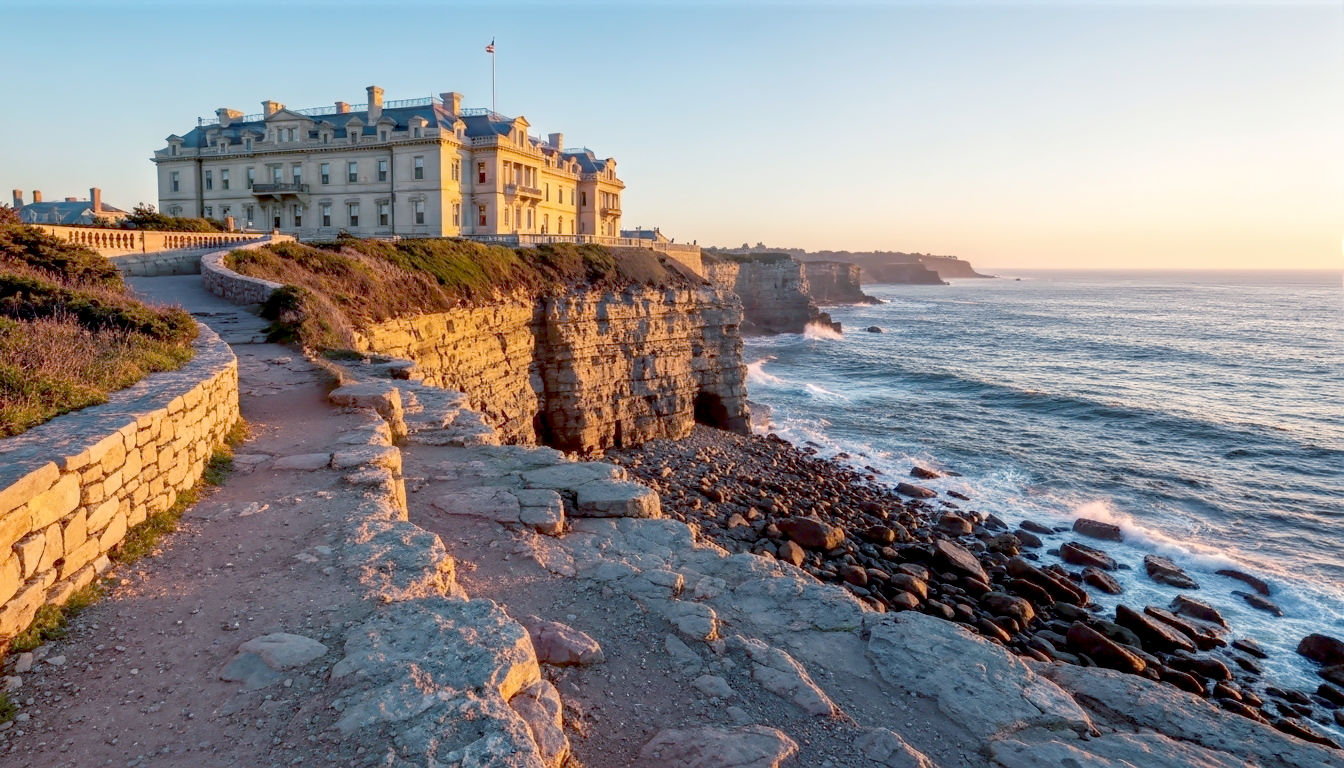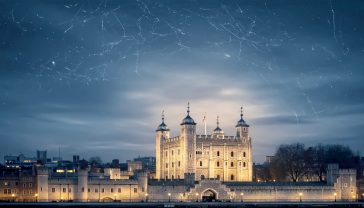The Rogue Island: A Complete History of Rhode Island from Pre-Colonial Times to Modern-Day ‘Little Rhody’
Explore the fascinating and rebellious history of America’s smallest state. This definitive guide covers everything from its founding to its modern identity.

This post may contain affiliate links. If you make a purchase through these links, we may earn a commission at no additional cost to you.
Rhode Island. The name might conjure images of quaint seaside towns, grand Newport mansions, or perhaps just a rather small space on a map of the United States. But don’t let its size fool you. Known affectionately as ‘Little Rhody’, this tiny state packs a punch, boasting a history that is as rebellious, influential, and downright fascinating as any of its larger neighbours.
For a British reader, the story of Rhode Island is a curious one. It’s a tale that starts not with loyalty to the Crown, but with defiance against the religious establishment of its fellow colonies. It was founded by a man kicked out of Massachusetts for having the cheek to suggest that people should be free to worship as they please and that the land should be bought from the Native Americans, not just taken. Imagine! This small patch of land became a haven for dissenters, freethinkers, and those who simply didn’t fit in anywhere else.
From its radical beginnings, Rhode Island charted its own course. It became a powerhouse in the dark trade of enslaved people, a cradle of the American Industrial Revolution, a magnet for immigrants from across Europe, and a place where organised crime once held sway. It’s a story of contradictions—a place founded on liberty that profited from slavery, a state of fierce independence that was the last to join the United States. So, grab a cuppa, and let’s unravel the rich, complex, and often surprising history of America’s smallest state.
The Land Before the Colony: The Narragansett People
Long before any Europeans with funny hats and buckled shoes arrived, the land that would become Rhode Island was home to several Native American peoples. The most powerful and prominent among them were the Narragansett tribe. Their name means “people of the small point,” and their territory covered most of what we now know as the state.
The Narragansett weren’t just wandering about. They were a sophisticated society. They lived in settled villages of wetuomash—domed huts made from saplings and bark—and were skilled farmers. They grew maize (what we call corn), beans, and squash, a trio of crops known as the “Three Sisters” that grew together in a rather clever, symbiotic way. The corn provided a stalk for the beans to climb, the beans fixed nitrogen in the soil, and the squash’s broad leaves shaded the ground, keeping it moist and weed-free.
Their lives were governed by the seasons. In the warmer months, they lived near the coast, fishing in the rich waters of Narragansett Bay and gathering shellfish like clams and oysters. In the winter, they moved inland to hunt deer, bear, and turkey in the forests. They were also skilled craftsmen, creating beautiful pottery and carving tools and ornaments from stone, bone, and wood. Their currency, called wampum, consisted of polished beads made from whelk and quahog shells, and it was used in trade and for ceremonial purposes across the region.
The Narragansett were led by powerful chiefs, or sachems, and by the early 1600s, their paramount sachems were Canonicus and his nephew, Miantonomi. They governed a population of thousands and held a position of respect and strength among the neighbouring tribes, like the Wampanoag to the east and the Pequot to the west. Their world was one of deep spiritual beliefs, intricate social structures, and a profound connection to the land. This was the established world that was about to be turned upside down.
A Haven for Heretics: Roger Williams and the Founding of Providence
The story of European settlement in Rhode Island begins with a man who was, by all accounts, a bit of a troublemaker. His name was Roger Williams. Born in London around 1603, Williams was a Puritan minister who, like many others, sought religious freedom in the New World. He arrived in Massachusetts Bay Colony in 1631, but he quickly found that their idea of “religious freedom” was rather narrow—it was freedom for them and them alone.
Williams had some radical ideas that didn’t sit well with the stern Puritan leaders in Boston. He argued for what he called “soul liberty,” the revolutionary concept that an individual’s conscience was a private matter between them and God. He believed the government had no right to compel religious observance or punish people for their beliefs. This was heresy to the Massachusetts authorities, whose entire society was built on a strict, state-enforced religious code.
He also made another powerful enemy by questioning the King’s right to grant land charters in America. Williams argued, quite reasonably, that the land belonged to the Native Americans and that colonists should purchase it from them fairly rather than claiming it by royal decree.
Kicked Out into the Wilderness
Unsurprisingly, the Massachusetts bosses soon ran out of patience. In the freezing winter of 1636, they banished Roger Williams from the colony. He trudged through the snow for days, eventually finding shelter with the Wampanoag people. Later that year, he negotiated with the Narragansett sachems, Canonicus and Miantonomi, and purchased a tract of land at the head of Narragansett Bay. He named his new settlement Providence, in thanks to God for protecting him.
Providence was founded on principles that were astonishing for the time. It was to be a place of complete religious toleration for all, including Baptists, Quakers, Jews, and even non-believers. Furthermore, it established a clear separation between church and state. It was the first colony in the modern world to be founded on such ideals. Williams’s experiment in “soul liberty” attracted other free-thinkers and religious exiles, who soon established other towns.
The Rise of the Rogue’s Island
One of the most notable figures to follow Williams was Anne Hutchinson. A sharp, charismatic woman, Hutchinson was also exiled from Massachusetts for challenging the religious authorities. In 1638, she and her followers founded the town of Portsmouth on Aquidneck Island. Another group, led by William Coddington, split off to establish Newport at the southern end of the island in 1639. A fourth settlement, Warwick, was founded in 1642 by Samuel Gorton, yet another religious radical.
These four separate, fiercely independent towns were a chaotic bunch. They squabbled over land and religion and were surrounded by bigger, more powerful colonies that viewed them as a nest of heretics and anarchists—a “Rogue’s Island.” To protect themselves, Roger Williams travelled to England in 1644 and, amidst the turmoil of the English Civil War, secured a parliamentary patent that loosely united the four towns into a single colony: The Colony of Rhode Island and Providence Plantations.
This was formalised in 1663 when King Charles II, perhaps in a tolerant mood following the Restoration, granted Rhode Island a Royal Charter. This remarkable document guaranteed complete religious freedom and established a democratic government. It was so forward-thinking that it served as the basis for Rhode Island’s state constitution right up until 1843.
Commerce, Conflict, and Complicity: The 18th Century
Rhode Island’s geography, with the magnificent Narragansett Bay cutting deep into its heart, destined it to be a maritime colony. Its merchants and sailors couldn’t rely on farming the rocky soil, so they turned to the sea. They became key players in the colonial economy, especially in what became known as the Triangular Trade.
The Dark Triangle
This was a brutal but highly profitable system. Ships would depart from ports like Newport and Bristol, laden with rum distilled in the colony. They sailed to West Africa, where the rum was traded for captured African men, women, and children. The ships, now packed with human cargo in horrific conditions, then endured the infamous “Middle Passage” across the Atlantic to the Caribbean or the southern colonies. The enslaved Africans were sold, and the ships were loaded with sugar and molasses, which were brought back to Rhode Island to be distilled into more rum.
Rhode Island dominated the North American slave trade. For a colony founded on the principle of liberty, this is a deeply uncomfortable and tragic irony. Historians estimate that Rhode Island merchants sponsored over 1,000 slaving voyages, transporting more than 100,000 Africans into bondage. The wealth generated from this trade built the elegant mansions of Newport and the fortunes of its leading families, like the Browns of Providence, whose name still adorns the famous university.
Stirrings of Rebellion
While profiting from the slave trade, Rhode Islanders were also developing a strong streak of independence from British control. Their reputation for smuggling and tax evasion was legendary. They deeply resented British attempts to regulate their trade through measures like the Sugar Act of 1764.
This resentment boiled over into open defiance. In 1772, a group of Rhode Islanders in a longboat rowed out to the British customs schooner, the HMS Gaspee, which had run aground near Warwick. They boarded the ship, wounded its commander, and burned it to the waterline. It was one of the earliest and most dramatic acts of violent rebellion against the Crown in the colonies. When the British tried to find the culprits, the locals all developed a sudden case of amnesia. No one was ever charged.
When the American War of Independence broke out in 1775, Rhode Island was the first colony to declare its independence from Great Britain, doing so on May 4, 1776—a full two months before the Declaration of Independence was signed in Philadelphia. The state contributed troops and leaders to the cause, most notably Nathanael Greene, a Quaker-turned-general who became one of George Washington’s most trusted commanders. The war hit Rhode Island hard, especially Newport, which was occupied by the British for three years. But the state’s rebellious spirit remained unbroken.
The Industrial Revolution and the Rise of the Mills
After the war, Rhode Island continued its non-conformist streak. It was the last of the original thirteen states to ratify the U.S. Constitution, holding out until 1790, fearful that a strong central government would threaten its cherished independence (and its lucrative trade).
As the 18th century closed, a new revolution was dawning, and Rhode Island was at its epicentre. In 1790, a young English immigrant named Samuel Slater arrived in Pawtucket. Slater had worked in the textile mills of Derbyshire and carried in his head the secrets of Richard Arkwright’s revolutionary water-powered spinning frame. At the time, it was illegal to export textile machinery or designs from Britain, so Slater was, in essence, an industrial spy.
The Birth of the American Factory
Working with a local merchant named Moses Brown, Slater recreated the machinery from memory. In 1793, Slater Mill began operation on the Blackstone River. It was the first successful water-powered cotton-spinning factory in America. This single event is often cited as the beginning of the Industrial Revolution in the United States.
Mills sprang up all along the Blackstone and other Rhode Island rivers. These factories needed workers, and a new way of life emerged. Entire families, including young children, were employed in the mills, working long hours in difficult conditions. This “Rhode Island System” involved creating entire mill villages, with the company providing housing, stores, and churches for its workers, creating a system of paternalistic control.
The textile industry transformed Rhode Island’s economy and landscape. It shifted the state’s centre of power from the coastal merchants of Newport to the industrial magnates of Providence. The demand for labour also began to change the state’s population, drawing in workers from rural areas and, later, from overseas.
A Changing Tide: Immigration and Political Upheaval
The 19th century was a period of immense change. The factory jobs, gruelling as they were, acted as a powerful magnet. The first major wave of immigrants came from Ireland, fleeing the Great Famine in the 1840s. They were followed by French Canadians seeking work in the mills, and later in the century, by waves of Italians, Portuguese, Poles, and Eastern European Jews.
These new arrivals provided the muscle for Rhode Island’s industrial machine, but they also faced prejudice and hardship. They crowded into urban neighbourhoods in cities like Providence and Woonsocket, creating vibrant ethnic communities but often living in poor conditions. The original English, or “Yankee,” Protestant elite looked down on these new Catholic and Jewish immigrants.
The Fight for the Vote
This social tension was mirrored in a major political crisis. Rhode Island was still operating under its 1663 Royal Charter, which restricted voting rights to landowners. By the 1840s, with the rise of a large, landless factory workforce, more than half of the state’s adult white men were unable to vote.
This led to a movement for constitutional reform led by Thomas Dorr. When the established government refused to act, Dorr and his followers held their own “People’s Convention,” drafted a new, more liberal constitution, and held an election which Dorr won. For a brief period in 1842, Rhode Island had two competing governments. The Dorr Rebellion, as it became known, was a tense but mostly bloodless affair. Dorr was eventually arrested for treason, but the rebellion scared the ruling elite into action. A new state constitution was adopted in 1843, which expanded voting rights, though it still included property requirements designed to limit the power of the new immigrant communities.
The Gilded Age, the Mob, and Modern ‘Little Rhody’
By the late 19th and early 20th centuries, Rhode Island’s industrial wealth was on full display. This was the Gilded Age, a term coined by Mark Twain to describe the period’s glittering surface of prosperity that hid underlying social problems. Nowhere was this more evident than in Newport. America’s wealthiest families—the Vanderbilts, the Astors, the Morgans—built their spectacular summer “cottages” along the cliffs, opulent palaces designed for a few months of lavish parties. Mansions like The Breakers and Marble House remain as monuments to an era of incredible inequality.
Decline and a New Kind of Power
The good times didn’t last. The textile industry, which had been the backbone of Rhode Island’s economy for over a century, began to decline after World War I. Mills started moving south, seeking cheaper labour and non-unionised workforces. The Great Depression of the 1930s hit the state incredibly hard.
As the old Yankee industrial power faded, a new power structure was emerging. The immigrant communities, particularly the Irish and Italians, had organised politically. They built powerful Democratic party machines that came to dominate state politics for much of the 20th century.
This period also saw the rise of organised crime. For decades, the Patriarca crime family, a faction of the New England Mafia, operated with near impunity from its headquarters on Federal Hill in Providence. Its powerful boss, Raymond L.S. Patriarca, held sway over a vast criminal empire from the 1950s until his death in 1984. The legacy of corruption in state and local politics took decades to clean up.
Re-inventing ‘Little Rhody’
The latter half of the 20th century was a period of reinvention. The state’s economy diversified away from manufacturing into sectors like healthcare, education, and tourism. The “Providence Renaissance” in the 1990s saw the city’s rivers uncovered and revitalised, creating the beautiful Waterplace Park and the popular WaterFire art installation. The creative energy of institutions like the Rhode Island School of Design (RISD) and Brown University helped transform Providence into a hub for arts and culture.
Today, Rhode Island embraces its history while looking to the future. It’s a state of contrasts—home to world-class universities and pockets of rural poverty, historic colonial towns and bustling city centres. Its rebellious, independent spirit, first embodied by Roger Williams, endures. It may be the smallest state, but its story is a microcosm of the American experience: a tale of principle and prejudice, liberty and slavery, decline and renewal. It’s a reminder that great things, and great stories, often come in small packages.
Further Reading
- Rhode Island Historical Society: The premier organisation for the state’s history.
- The Providence Journal: The state’s leading newspaper, with extensive archives.
- Preservation Society of Newport County: For information on the Gilded Age mansions.
- Slater Mill Historic Site: Learn about the birthplace of the American Industrial Revolution.






